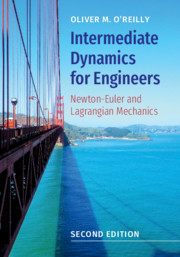Refine search
Actions for selected content:
2002 results in Engineering design, kinematics, and robotics
2 - Reference Kinematics
-
- Book:
- Dynamics of Multibody Systems
- Published online:
- 14 September 2020
- Print publication:
- 05 March 2020, pp 28-78
-
- Chapter
- Export citation
9 - Integration of Geometry, Durability Analysis, and Design
-
- Book:
- Dynamics of Multibody Systems
- Published online:
- 14 September 2020
- Print publication:
- 05 March 2020, pp 345-370
-
- Chapter
- Export citation

Intermediate Dynamics for Engineers
- Newton-Euler and Lagrangian Mechanics
-
- Published online:
- 08 February 2020
- Print publication:
- 30 January 2020
-
- Textbook
- Export citation
Appendix A - Background on Tensors
-
- Book:
- Intermediate Dynamics for Engineers
- Published online:
- 08 February 2020
- Print publication:
- 30 January 2020, pp 488-502
-
- Chapter
- Export citation
11 - The Dynamics of Systems of Particles and Rigid Bodies
- from Part IV - Systems of Particles and Rigid Bodies
-
- Book:
- Intermediate Dynamics for Engineers
- Published online:
- 08 February 2020
- Print publication:
- 30 January 2020, pp 431-487
-
- Chapter
- Export citation
Part I - A Single Particle
-
- Book:
- Intermediate Dynamics for Engineers
- Published online:
- 08 February 2020
- Print publication:
- 30 January 2020, pp 1-2
-
- Chapter
- Export citation
1 - Kinematics of a Particle
- from Part I - A Single Particle
-
- Book:
- Intermediate Dynamics for Engineers
- Published online:
- 08 February 2020
- Print publication:
- 30 January 2020, pp 3-41
-
- Chapter
- Export citation
3 - Lagrange’s Equations of Motion for a Single Particle
- from Part I - A Single Particle
-
- Book:
- Intermediate Dynamics for Engineers
- Published online:
- 08 February 2020
- Print publication:
- 30 January 2020, pp 81-134
-
- Chapter
- Export citation
Frontmatter
-
- Book:
- Intermediate Dynamics for Engineers
- Published online:
- 08 February 2020
- Print publication:
- 30 January 2020, pp i-iv
-
- Chapter
- Export citation
6 - Rotations and their Representations
- from Part III - A Single Rigid Body
-
- Book:
- Intermediate Dynamics for Engineers
- Published online:
- 08 February 2020
- Print publication:
- 30 January 2020, pp 203-256
-
- Chapter
- Export citation
Part II - A System of Particles
-
- Book:
- Intermediate Dynamics for Engineers
- Published online:
- 08 February 2020
- Print publication:
- 30 January 2020, pp 135-136
-
- Chapter
- Export citation
Part III - A Single Rigid Body
-
- Book:
- Intermediate Dynamics for Engineers
- Published online:
- 08 February 2020
- Print publication:
- 30 January 2020, pp 201-202
-
- Chapter
- Export citation
5 - Dynamics of Systems of Particles
- from Part II - A System of Particles
-
- Book:
- Intermediate Dynamics for Engineers
- Published online:
- 08 February 2020
- Print publication:
- 30 January 2020, pp 170-200
-
- Chapter
- Export citation
9 - Kinetics of a Rigid Body
- from Part III - A Single Rigid Body
-
- Book:
- Intermediate Dynamics for Engineers
- Published online:
- 08 February 2020
- Print publication:
- 30 January 2020, pp 329-378
-
- Chapter
- Export citation
2 - Kinetics of a Particle
- from Part I - A Single Particle
-
- Book:
- Intermediate Dynamics for Engineers
- Published online:
- 08 February 2020
- Print publication:
- 30 January 2020, pp 42-80
-
- Chapter
- Export citation
Preface
-
- Book:
- Intermediate Dynamics for Engineers
- Published online:
- 08 February 2020
- Print publication:
- 30 January 2020, pp xiii-xviii
-
- Chapter
- Export citation
References
-
- Book:
- Intermediate Dynamics for Engineers
- Published online:
- 08 February 2020
- Print publication:
- 30 January 2020, pp 503-521
-
- Chapter
- Export citation
Part IV - Systems of Particles and Rigid Bodies
-
- Book:
- Intermediate Dynamics for Engineers
- Published online:
- 08 February 2020
- Print publication:
- 30 January 2020, pp 429-430
-
- Chapter
- Export citation
7 - Kinematics of Rigid Bodies
- from Part III - A Single Rigid Body
-
- Book:
- Intermediate Dynamics for Engineers
- Published online:
- 08 February 2020
- Print publication:
- 30 January 2020, pp 257-298
-
- Chapter
- Export citation
Dedication
-
- Book:
- Intermediate Dynamics for Engineers
- Published online:
- 08 February 2020
- Print publication:
- 30 January 2020, pp v-vi
-
- Chapter
- Export citation
